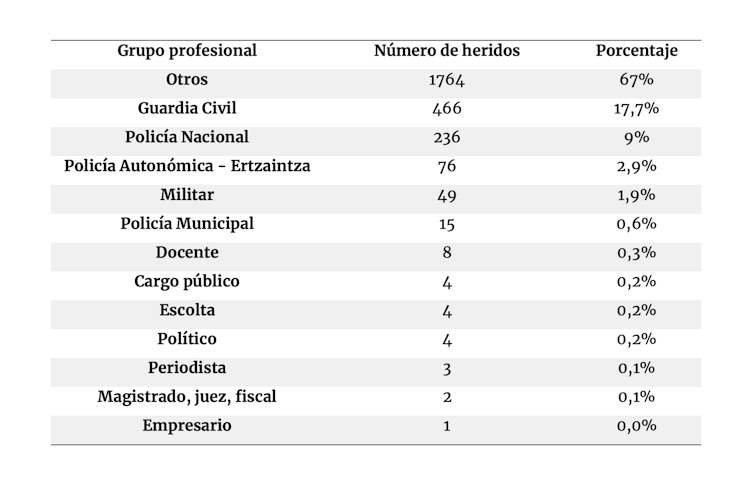29/06/2022
Published in
The Conversation
María Jiménez
Professor of the School of Communication
Gaizka Fernández
manager from area of file, research and Documentation, Memorial Center for the Victims of Terrorism.
The study of the effects caused by ETA terrorism necessarily involves attention to the wounded, a group that has traditionally been relegated in legislative, academic and journalistic terms, in the shadow of the 853 fatal victims of the gang. Its size, however, highlights its importance: at least 2,632 people directly affected by the physical or psychological after-effects of an ETA attack. Both they and the relatives who have cared for them over the years have suffered, and many still suffer, the consequences of the violence.
For this research, published in its entirety on the journal History and Politics and which follows in the footsteps of the book Wounded and forgotten. The Survivors of Terrorism in SpainThe Victims of Terrorism Memorial Centre, we had access to the Ministry of the Interior's official register of the wounded.
This list includes the wounded recognised after an administrative process that was not systematised until the approval of the Law for the Recognition and Comprehensive Protection of Victims of Terrorism in 2011, five decades after ETA's activity began.
However, it is the most rigorous source available and the only one that can provide socio-demographic information on the profile of the injured. It is also a living register, as the files are still being processed: since 2012 and up to April 2020, 54 people have been recognised as having been injured as a result of ETA terrorist activity.
The profile of the wounded
Of the almost 5,000 people injured by terrorism in Spain, ETA is manager responsible for 54%. Six out of ten suffered injuries that were not serious. However, 32%, i.e. 858 people, were diagnosed with life-long disabilities. The major invalids, the group group of survivors with the most severe after-effects, comprised 40 people.
Table 1. Degree of the sequelae recognised in ETA casualties.
With regard to the socio-demographic profile , of the 2,632 people injured, the vast majority, 2,519, are of Spanish nationality. The rest came from 16 different countries. Most of them were young: around 55% were under 40 years of age and the age average of all of them was 34.5 years old. 174 were minors.
And their profession? The State Security Forces and the Armed Forces account for 32% of those injured by ETA. The Civil Guard is the most targeted group, accounting for almost 18% of those injured. Another 67% corresponds to people who do not fall into any of the professional groups identified, so that in any case they would be civilians. The figures are completed by small percentages of other professionals who were nevertheless targeted by the terrorist organisation: teachers, bodyguards, politicians, businessmen, journalists and judicial officials.
Table 2. group professional to which the ETA casualties belong
issue Madrid is the region with the highest number of injured, 663, followed by two Basque provinces, Guipúzcoa and Vizcaya, with 476 and 393 injured, respectively. The fourth region is neighbouring Navarre, with 201.
The correlation between the number of wounded and ETA's strategic evolution
The decade in which ETA's terrorist activity caused the most injuries was the first decade of the 21st century, which contrasts with the fact that the years with the most fatalities were the so-called "years of lead", specifically 1980, 1979 and 1978.
Between 2000 and 2009, 34.6 % of the wounded were recorded, a slightly higher percentage than during the 1980s, when, however, the highest percentage of the terrorist organisation's fatalities were concentrated.
This shows that there is a direct relationship between ETA's strategic evolution and the physical and psychological after-effects it provoked. By employing selective methods such as firearms, during the dictatorship and the Transition the numbers of wounded remained relatively low and were lower than those of its fatalities. During this period, the professional category hardest hit by terrorism was that of the State Security Forces and the Armed Forces, a favourite target of ETA in general and its military branch in particular.
Table 3. Evolution of the number of people injured by ETA and its milieu between 1965 and 2016
In the mid-1980s, due to the inability to keep up the pace of actions, the use of car bombs intensified to carry out attacks, which in many cases were indiscriminate, causing the number of wounded to skyrocket. As a result, the proportion of civilian casualties increased and the proportion of law enforcement and military casualties decreased.
This dynamic was further accentuated during the "socialisation of suffering" stage. To disguise its organisational weakness, ETA perpetrated bomb attacks that caused many casualties, while its youthful environment turned to kale borroka.
However, defeated by the rule of law, in 2011 the gang announced the cessation of violence and, seven years later, its dissolution.



